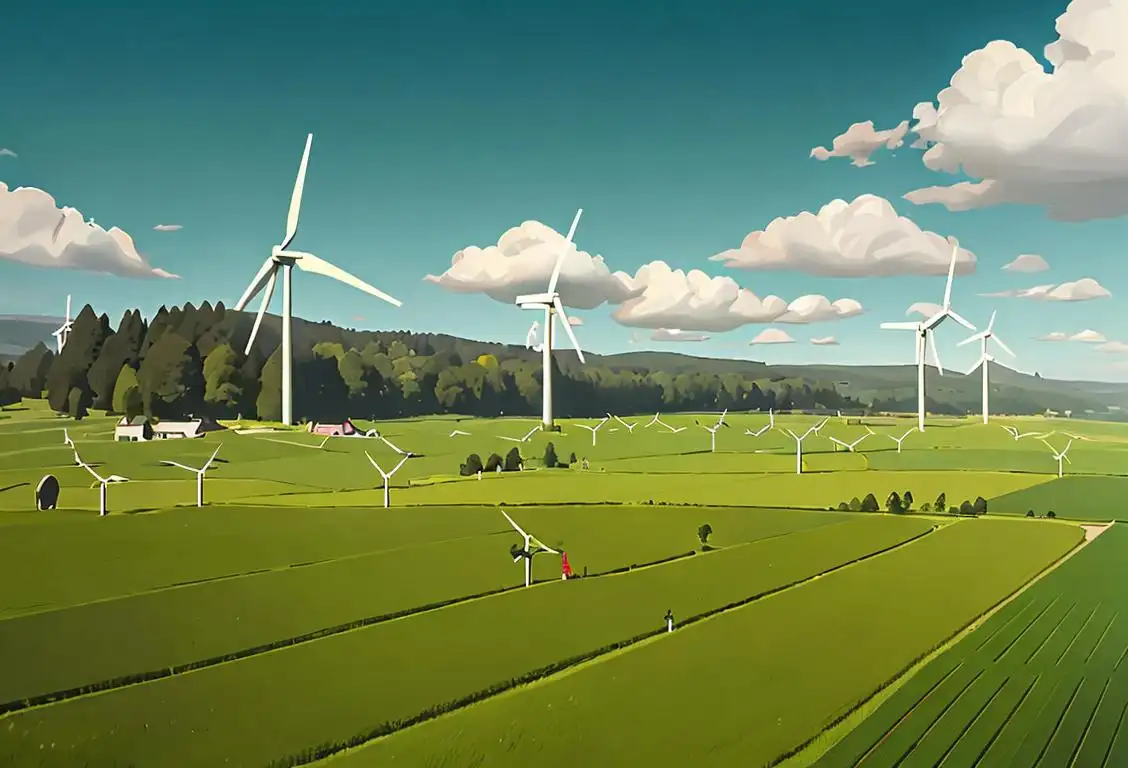National Bioenergy Day

Attention all bioenergy enthusiasts! Get ready to celebrate National Bioenergy Day, a day dedicated to promoting the use of sustainable and renewable energy sources. Whether you're a tree hugger or just excited about the prospect of saving money on utility bills, this is the day for you!
When is Bioenergy Day?
It's national bioenergy day on the 21st October.
The Origins of National Bioenergy Day
Every year on October 21st, National Bioenergy Day takes center stage. This special day was first established to raise awareness about the benefits of renewable energy derived from biomass and biofuels. From wood pellets to organic waste, bioenergy offers an eco-friendly alternative to traditional energy sources and helps reduce our dependence on fossil fuels.
Celebrating National Bioenergy Day
So, how can you celebrate National Bioenergy Day? Here are a few energizing ideas:
- Organize a community event to showcase the importance of bioenergy and invite local experts to share their knowledge.
- Visit a biomass power plant or biofuel facility to learn how these innovative technologies work.
- Start a DIY project using wood pellets or other bioenergy products. Maybe it's time to finally build that eco-friendly birdhouse you've been talking about!
Fun Fact about Bioenergy
Did you know that bioenergy has been used for thousands of years? Ancient civilizations used biomass to heat their homes and cook their food. They were the original bioenergy pioneers!
History behind the term 'Bioenergy'
1850
First Mention in Literature
The term 'bioenergy' was first mentioned in literature in the year 1850. It was used in German literature as 'bioenergie', which combines the Greek word 'bios', meaning life, and the German word 'energie', meaning energy. This term was used to describe the energy derived from living organisms.
1796
Discovery of biogas
In 1796, Italian inventor Alessandro Volta discovered biogas, a mixture of gases produced by the breakdown of organic matter in the absence of oxygen. This discovery laid the foundation for the term 'bioenergy', as it revealed the potential to harness energy from renewable sources like agricultural waste and wastewater.
1801
Discovery of bioenergy potential
In 1801, the French chemist and inventor Philippe Lebon identified the potential of utilizing organic matter as a source of energy. He discovered that by heating wood in the absence of air, it produced a gas he named 'gas d'éclairage' (lighting gas), which could be used for lighting and heating purposes. This marked the first recognition of bioenergy and its transformative power.
1921
The Discovery of Bioenergy
In 1921, German chemist Dr. Otto Meyerhof discovered the chemical process known as bioenergetics, which involves the study of energy flow through living systems. Meyerhof's groundbreaking work focused on understanding the conversion of chemical energy in living organisms, particularly how adenosine triphosphate (ATP) plays a crucial role in energy transfer. This groundbreaking research laid the foundation for the term 'bioenergy' and its subsequent development.
1860
Bioenergy application in street lighting
Around 1860, Sir William Siemens utilized biogas generated from sewage to fuel street lamps in London. This marked one of the earliest practical applications of bioenergy, highlighting its potential as a sustainable alternative to traditional fossil fuels.
1883
Introduction of Biogenic Philosophy
In 1883, the German philosopher Hans Driesch introduced the concept of 'biogenic philosophy', which emphasized the interconnectedness of all living things and their inherent energy. This philosophy contributed to the development of the term 'bioenergy' and its understanding as a form of energy sourced from biomass.
1940s
Bioenergy in Agriculture
During the 1940s, the concept of bioenergy gained traction in the agricultural industry. Farmers recognized the potential of organic materials, such as crop residues and animal manure, as a source of renewable energy. Utilizing these organic materials for heating, cooking, and transportation purposes allowed for a more sustainable and cost-effective approach to agriculture.
1860
Development of biogas technology
During the mid-19th century, biogas technology started to emerge. In 1860, the German engineer and scientist Eugen von Gorczynski built the first anaerobic digester to produce biogas from animal manure. This breakthrough showcased the potential of harnessing organic waste to generate energy, leading to further advancements in the field of bioenergy.
1970
Emergence of Modern Bioenergy
In the 1970s, as concerns regarding fossil fuel depletion and environmental sustainability grew, the term 'bioenergy' gained significant attention. Researchers and scientists started exploring and developing modern bioenergy technologies, such as biofuels and biogas, to reduce reliance on fossil fuels and mitigate their environmental impact.
1970s
The Rise of Bioenergy as an Alternative Energy Source
In the 1970s, amidst increasing concerns about fossil fuel depletion and environmental pollution, the term 'bioenergy' became closely associated with the development of renewable energy sources. Bioenergy gained prominence as an alternative to conventional fossil fuels, with a focus on utilizing biomass, such as wood, agricultural residues, and dedicated energy crops, to produce heat, electricity, and transport fuels. The rise of bioenergy was driven by the desire for cleaner and sustainable energy solutions.
1895
Emergence of the term 'bioenergy'
The term 'bioenergy' was coined in 1895 by Swedish chemist Svante Arrhenius. He used it to describe the energy derived from biomass, which encompasses organic materials such as wood, agricultural residues, and other biological sources. Arrhenius recognized the importance of renewable energy in mitigating environmental impact and introduced the concept of bioenergy to the scientific community.
1895
Birth of biopower through agricultural residues
In 1895, the world's first biopower plant utilizing agricultural residues was established in Stillwater, Minnesota, United States. The plant generated electricity by burning corn stalks, paving the way for the utilization of agricultural waste as a renewable energy source. This marked a significant milestone in the development of bioenergy as a viable alternative to fossil fuels.
2000
Recognition of Bioenergy as Renewable Energy
Around the year 2000, international organizations and governments officially recognized bioenergy as a renewable energy source. This recognition was based on the fact that bioenergy is derived from organic matter that can be continuously replenished, such as crops, agricultural waste, and forestry residues.
2000s
Bioenergy in the Global Energy Landscape
In the 2000s, bioenergy emerged as a crucial component in the global energy landscape. The term encompassed a wide range of technologies, including biofuels, biogas, and biomass power generation. Governments and policymakers began implementing bioenergy strategies to reduce greenhouse gas emissions, enhance energy security, and stimulate rural development. The production of bioenergy expanded significantly, with countries investing in research and development to improve efficiency and sustainability in the bioenergy sector.
1970
Expansion of bioenergy applications
During the 1970s, as concerns about fossil fuel depletion and environmental issues grew, the interest in bioenergy expanded. Research and development efforts focused on improving biofuel production, particularly ethanol derived from crops such as corn and sugarcane. This period saw the emergence of bioenergy as a renewable and sustainable alternative to traditional energy sources.
1979
Bioenergy gains global attention
In 1979, the United Nations Conference on New and Renewable Sources of Energy took place in Nairobi, Kenya. This conference brought bioenergy to the forefront of global discussions as a viable and sustainable energy solution. The event emphasized the need to explore and develop bioenergy technologies to address the world's rising energy demands and reduce dependence on fossil fuels.
2001
Rise of bioenergy as a global priority
In 2001, the United Nations designated the year as the 'International Year of Bioenergy' to raise awareness about its potential as a sustainable energy solution. This global recognition brought more attention to bioenergy research, development, and implementation worldwide. Governments and organizations started investing in bioenergy infrastructure and technologies, contributing to its growing prominence in the transition towards a greener future.
Present
Expansion and Diversification of Bioenergy
In the present day, bioenergy has evolved into a diverse and expanding field. It encompasses a range of technologies, including biofuel production, biomass power generation, and biogas utilization. Bioenergy plays a crucial role in the transition towards a more sustainable and low-carbon energy system, offering opportunities for reducing greenhouse gas emissions and fostering rural development.
1997
International Bioenergy Day established
In 1997, the World Bioenergy Association (WBA) declared October 21st as International Bioenergy Day. This annual observance aims to raise awareness about the potential of bioenergy, promoting its positive environmental and socioeconomic impacts. It serves as a platform for sharing knowledge, showcasing innovations, and fostering dialogue among experts, policymakers, and the general public.
Present
Bioenergy's role in mitigating climate change
Today, bioenergy plays a crucial role in efforts to mitigate climate change and reduce greenhouse gas emissions. It encompasses various forms, including biofuels, biopower, and biomethane. Bioenergy offers a renewable and carbon-neutral energy source, as plant-based feedstocks capture CO2 during their growth. Ongoing research focuses on developing advanced bioenergy technologies, sustainable feedstock production, and ensuring bioenergy's environmental and social sustainability in the years to come.
Did you know?
Did you know that bioenergy has been used for thousands of years? Ancient civilizations used biomass to heat their homes and cook their food. They were the original bioenergy pioneers!Tagged
awareness green energy sustainability eco-friendlyFirst identified
12th October 2015Most mentioned on
21st October 2015Total mentions
272Other days
Bioenergy Day
Cut Your Energy Costs Day
Skip The Straw Day
Pistachio Day
Clean Air Day
Hydrogen And Fuel Cell Day
Energy Conservation Day
Oyster Day
Arbor Day
Hydrogen Day








